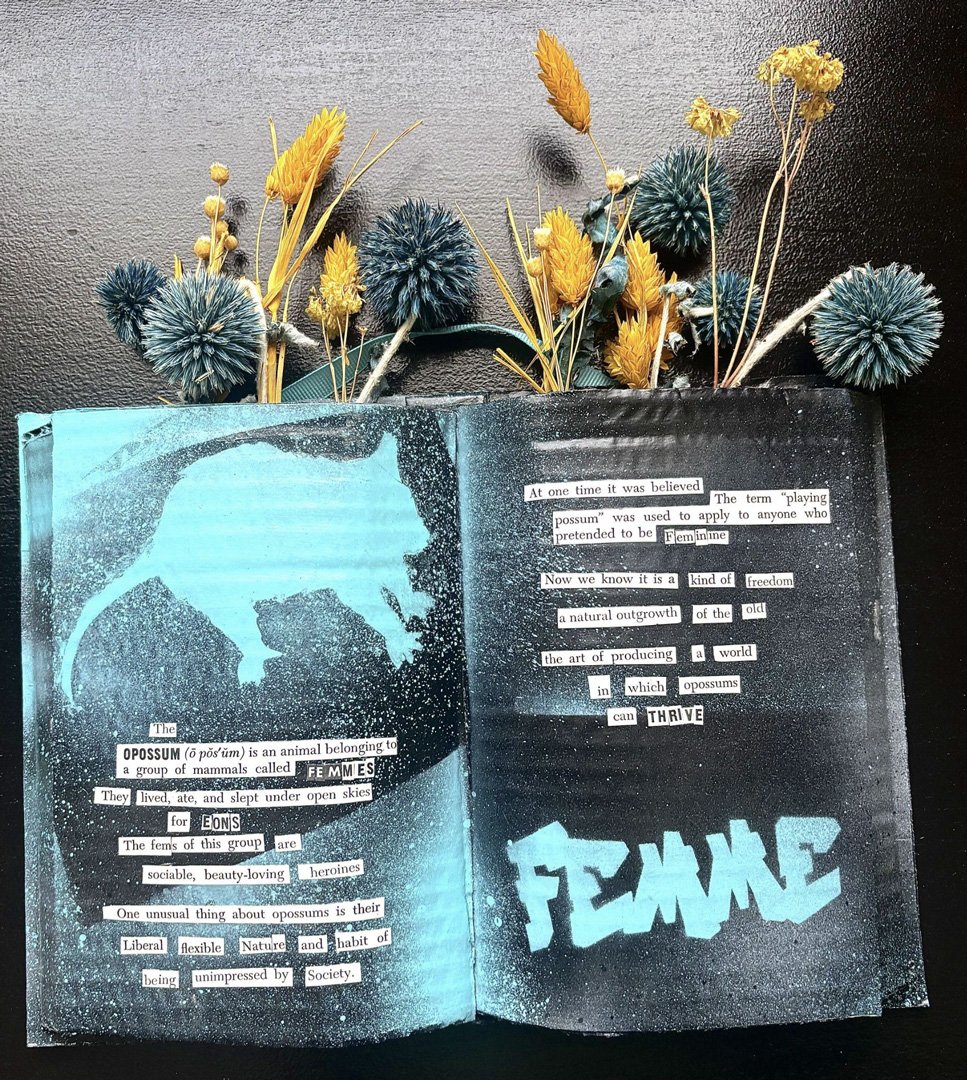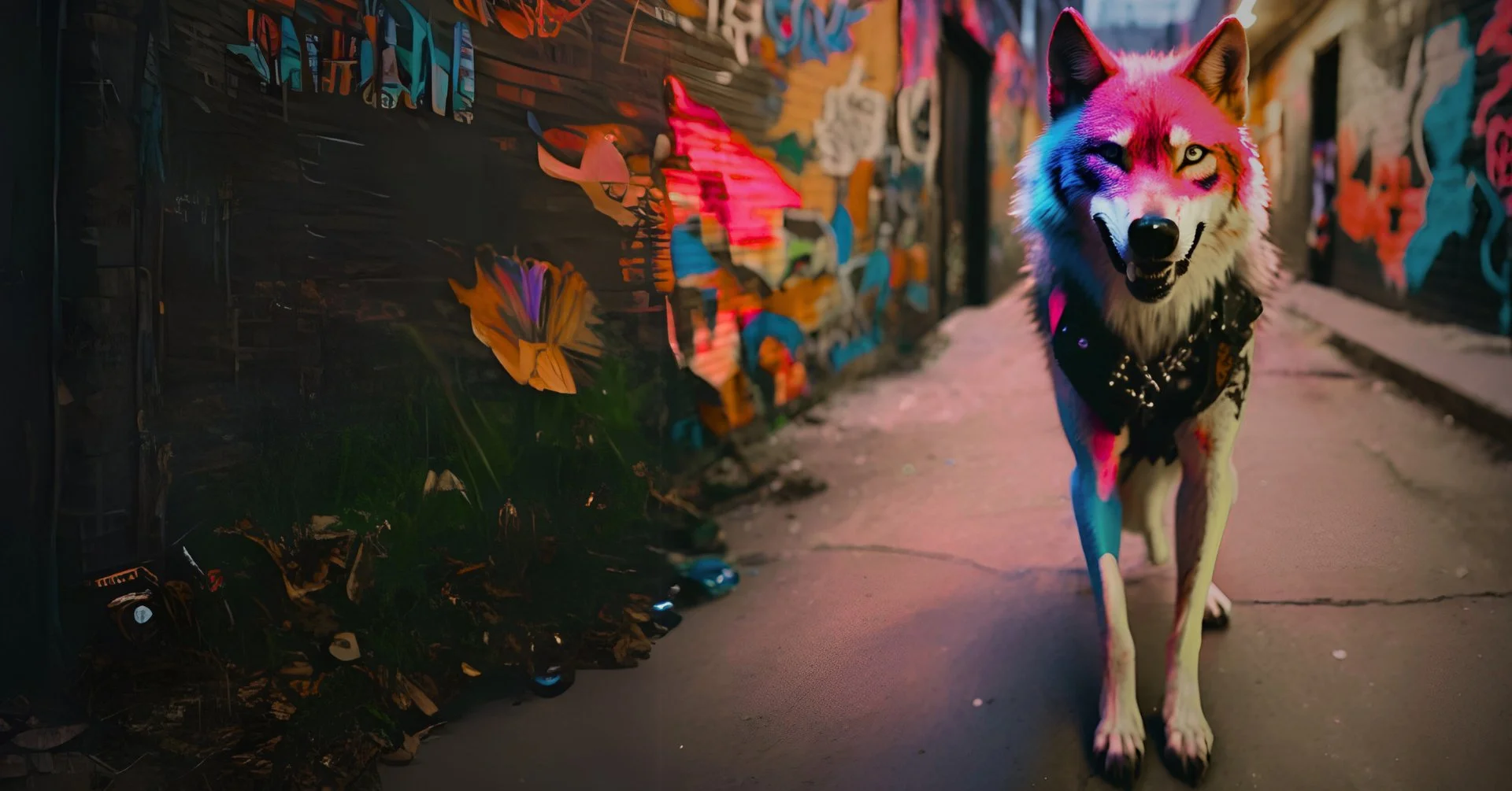Jessica Evett
Meet Jessica Evett: printmaker and collage artist
From:
Boise, ID
Medium:
Printmaking (linocut) and collage
For auction:
”Queen Collage” [pictured right], a linocut and textured paper collage with resin finish.
Other interesting details about me:
I also created the Blue Girl, Red State sticker in 2005 and this will be the 20th anniversary of that image starting to find its way to various bumpers across the state.
Images © Jessica Evett. Reproduced by permission.Q&A with Jessica Evett
What inspired you to create this piece?
While I'd finished this piece before the call for entries, the theme inspired me to finish the piece in resin and donate it to the cause. The composition is comprised of fragments that fit well together within our postmodern world. The piece reminds us that we form meaning from the broken, colorful fragments of the world if we choose to.
What’s your background and what led you to become an artist?
I grew up in Boise and went to College of Idaho and studied psychology and creative writing, although I originally wanted to study art and be a wolf biologist. As a kid I took a lot of art classes at Fort Boise and spent a lot of time just lurking in the pottery studio and making a lot of random projects at home. I’d always loved the outdoors and spent a lot of time camping and fishing with my dad growing up, but didn’t end up studying natural resources as an undergrad and kind of lost touch with that side for a while.
When my eventual husband and I moved to Bozeman in 1999 I found my way back to the outdoors with two years at the Montana Conservation Corps as a crewleader and Americorps volunteer. That experience led to 25 years of nonprofit work and federal service including several stints as a Forest Service wilderness ranger, taking a couple of years off to get a master’s degree in Mass Communications, spending several years working for grassroots stewardship organizations in Colorado, running a community radio station in Boise, and most recently working for the Idaho Humanities Council. I wouldn’t change any of that but I started getting back into writing poetry and visual art when I moved back here, and I found that some of the same hurdles that got in the way of my creative practice in my 20s and early 30s had diminished. I’ve been building up my visual art practice for several years now and started doing that full-time at the end of December out of my studio in Garden City. The main thing holding all of that jumble of experiences together is advocating for the importance of community when it comes to taking care of our mutual resources, something that I continue to explore with my art.
How long have you been making art?
As long as I can remember, but then I stopped making it seriously at some point after college. In some ways that was a mistake (I never should have given it up as a major) but for me it was more about putting my idealism and commitment to change into other aspects of my life. I think some of my Gen X cohort also felt it was OK to work and think about work to the point of burnout as long as it was in service of some ideal. I’ve loved all of my previous jobs but it was really time for me to put that creative energy toward my own creative output. In terms of dedicating myself to getting serious about a body of work and seeing how far I’ll be able to develop it, the last seven years or so have been a steady period of experimentation for me. This past year is the first time I’ve been able to do this full-time and it feels like an ocean of time in the right way.
What motivates you, or inspires your art?
The desire for change has always motivated me and it’s a good time to be making art that speaks to the analog and leaving my fingerprints on something. Although I experiment in whatever medium captures my interest at a given time, over the past several years I really honed in on relief prints since I wanted to control the means of production when it came to getting work out there and it’s highly accessible for the audience as well. Linocut is a great medium for autodidacts, particularly with how well it lends itself to the community sharing their process online. In terms of inspiration, both of my parents passed away in the past couple of years, and they were always very supportive of our pursuits. After they passed away, I came to terms with the fact that a long life well-lived is still short and if I waited another 15 years to do art full-time I might never get the chance to see what I can do with it. So at the end of 2024 I made the jump. Having a studio outside of the house and being a part of the community in Garden City and Spaceport has been a key part of me staying motivated and inspired.
Is there a specific message or emotion you want viewers to feel from your work?
Freedom.
The real deal kind.
Are there specific experiences and themes you explore in your art?
On my website, I describe the two different halves of my work as “Beauty and the Beast.” I kind of blame my junior high school teacher for proclaiming that “all art should be beautiful” in class one day since that marked the starting point of me honing in on a blend of humor and occasional ugliness in my work to prove that she was only half right. As I started making linocuts three years ago, I found myself pulled back into my collection of weird vintage magazines from the 30s, 50s, and 60s that I started accumulating in grad school. In particular, I’m fond of a health magazine called “Physical Culture” and a romance magazine called “True Romance” as places to find source images. I use photographs in there for source images for my “Demotivational Linocut” series and some of my more whimsical prints since it’s fun to translate mundane ephemeral photographs and change the context just enough to land a punch or create a double take. All that being said, my interpretation of the natural world rather than poking holes in our manufactured, colonized experience scratches a different itch. Anyone going to my studio usually picks up on the fact that there are wings constantly popping up in my work. My prints and collage work incorporating the natural world offer up a tactile experience and I lean more toward the kind of printmaking that embraces some elements of mess. While there’s something to be said for a fine edition of prints without any errors, I’ve learned to know when I’m striving for replication vs. experimentation.
Why do you believe in The Pro-Voice Project?
I have been really impressed with The Pro-Voice Project's thoughtful response to the Dobbs decision and frequently tell people about the project as an example of the kind of action we need right now. When I became aware of the group’s work last year up in North Idaho combining an art exhibit and multiple community conversations taking place over an extended period of time, I immediately wanted to learn more. Movements that are committed to changing the status quo, shattering of stigma, and normalizing an intersectional approach through storytelling on a local level are the ones that will allow us all to make a difference in our communities and shift the narrative. The Pro-Voice Project was formed by individuals with a deep connection to Idaho and extensive personal/professional experience, and part of the reason we all find ourselves here is that those are the very voices that we need to look to for leadership. Over the last ten years in particular, we’ve all seen a lot of national “movements” that eventually turn out to be more like memes when community isn’t centered. If we’re going to change anything for the better we need to become adept at organizing and acting with intention instead of just reacting with one step in mind. Storytelling is an essential piece of that.
Why is this movement important to you?
I have been incredibly impressed by the Pro-Voice Project for over a year after my former organization (Idaho Humanities Council) worked with the group on several community conversations up in North Idaho. The approach of narrative and conversation along with art offers a true alternative to how the "debate" of reproductive freedom has been framed for the past several decades. I would love the sale of this piece to support the long game in some small way.
What brought you to Idaho, and what keeps you here?
Thousands of years of empire, patriarchy, and fear continually pushing my ancestors around the globe in search of freedom but ultimately taking it away from others as they did that. So I figure this is where I’m supposed to be right now to help tell that story and make reparations where I can. That and my parents moved here in 1972, and after living in Colorado and Montana for 17 years my husband and I moved back here to be closer to my family. On a micro level, community and our public lands keep me here too.
Any other interesting details you'd like to share?
My prints are original linocuts designed, carved, and handprinted by me. Linocut is a type of relief print where the image is transferred onto a block of linoleum (a renewable resource we used to make floors out of), carved out with sharp tools, rolled with ink, and stamped on paper. I frequently make randomly colored monoprint backgrounds and use my designs on those as well to give you a truly original piece with some accidental effects. My collage work is both a way of repurposing prints that don't quite work in an edition and letting my head, heart, and hands travel to a different spot.
I also created the Blue Girl, Red State sticker in 2005 and this will be the 20th anniversary of that image starting to find its way to various bumpers across the state. The sticker was always less about party politics than it was about preserving human rights, and that sense of urgency has only increased over the years.
Connect with Jessica
I’ve got a website at jessicaevettartist.com, currently active on Instagram in the hopes that Meta gets broken up in a glorious anti-trust lawsuit, and I love to connect with people in person. Subscribing to my e-mail list on my website is one of the best ways to stay connected.
I generally always have my studio space in Garden City open for First Fridays in the Surel Mitchell Live, Work, Create District (June 6th and August 1st are the next two).
Instagram: @jessicaevettartist
Contributing Artists
-

Ashley Rayne
Sculpture & Multimedia
-

Chris Kingston
Lithography
-

Evalee Campbell
Multimedia
-

Gina Cole
Painting
-

Jamie Roberts
Collage
-

Jessica Evett
Printmaking & collage
-

Jodi Rawson
Painting
-

Kayla Hanson
Painting
-

Meghan Kahnle
Collage & Mixed Media
-

Meredith Bobb
Painting
-

Pat Raffee
Quilter
-

Patricia Wallace
Multimedia

Mosaic x Feral Joy
Pieces donated to the Mosaic initiative will be auctioned at PVP’s Feral Joy: A Night of Feminist Comedy, Art & Resistance on December 4, 2025 in Boise.



